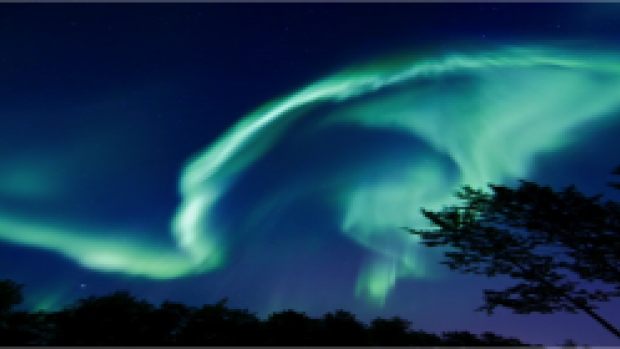Will NH and Maine residents see Northern Lights this week? What you need to know.
Astronomy enthusiasts in 17 states across the country, including New Hampshire and Maine, are gearing up for the possibility of witnessing the vibrant Northern Lights this week.
It is not a sure bet Seacoast and southern Maine residents will be able to cross viewing the dazzling display off their bucket lists, however. Experts say weather conditions and latitudinal positioning could get in the way.
Alaska, Idaho, Indiana, Maine, Maryland, Michigan, Minnesota, Montana, New Hampshire, New York, North Dakota, Oregon, South Dakota, Vermont, Washington, Wisconsin and Wyoming are predicted to potentially have views of the auroral event on Thursday night, per the Geophysical Institute at the University of Alaska at Fairbanks.
The Northern Lights, also known as aurora borealis, are best seen between the hours of 10 p.m. and 2 a.m., according to the the National Oceanic and Atmospheric Administration's Space Weather Prediction Center.

“When they’re visible, they’re beautiful. They’re striking,” said John Gianforte, a University of New Hampshire astronomy instructor and director of the school’s observatory.
What are the Northern Lights?
Sten Odenwald, author of “The 23rd Cycle: Learning to Live with a Stormy Star,” explained the phenomenon, formally known as aurora borealis.
The aurora begins on the surface of the sun when a coronal mass ejection occurs, which is the ejection of an invisible cloud of gas. Such masses can reach the Earth in between two and three days, striking the planet’s magnetic field.
“When a coronal mass ejection collides with the magnetic field, it causes complex changes to happen to the magnetic tail region. These changes generate currents of charged particles, which then flow along lines of magnetic force into the Polar Regions,” Odenwald wrote in the book. “These particles are boosted in energy in Earth’s upper atmosphere, and when they collide with oxygen and nitrogen atoms, they produce dazzling auroral light.”
The Space Weather Prediction Center states geomagnetic activity like aurora borealis strength and probability is measured on a scale of 0 to 9, known as the Kp index. Thursday’s Kp index, per the Geophysical Institute, is forecast to be 6.
“For Kp in the range 6 to 7, the aurora will move even further from the poles and will become quite bright and active,” the Space Weather Prediction Center reports. “At this geomagnetic activity level, it might be possible to see the aurora from the northern edge of the United States.”
On Sunday night, according to Gianforte, a solar flare occurred on the sun. While radiation from the flare moves at the speed of light, reaching Earth in just under eight and a half minutes, particles required for aurora borealis take between two and three days to hit Earth’s magnetic field, meaning the upcoming northern lights particles won’t reach the earth until later in the week.
What must happen for Northern Lights to be visible locally in NH and Maine
A range of conditions need to be met for the northern lights to be visible for those across the Seacoast and southern Maine this week. According to Gianforte, that includes clear skies and a lack of city or street lights as well as viewing from positions of higher elevation.
Weather conditions are not looking favorable as of this writing on Monday.
“If it’s cloudy, you’re not going to see anything. If it’s raining, don’t bother getting up,” Gianforte stated. “If it’s clear or a slight haze, you may be able to see something.”
The National Weather Service in Gray, Maine on Monday was projecting 75% cloud cover across the Seacoast and southern Maine on Thursday, in addition to scattered thunderstorms, said meteorologist Jon Palmer.
“Looks like the probabilities are slightly less along the immediate coast but there definitely is a decent chance for some thunderstorms Thursday night,” Palmer said.
If inclement weather holds off, the phenomenon could potentially be seen in the Seacoast and southern Maine and other areas in lower latitudes that aren’t prone to such spectacles, with shades of blue, green, purple and red light dancing in the sky.
“If we do get a clear patch of sky, and it hits us after 8 p.m. or 9 p.m., and if we look to the north, you could see something,” Gianforte added. “There’s a lot of things that have to happen just right for us to see the Northern Lights on Thursday night.”
There is a chance, he added, the particles from the coronal mass ejection could arrive in the daytime this week, meaning the aurora wouldn’t be visible.
“We kind of have to be a little bit careful not to build things up too much because no one really knows how fast the particles that are involved in the cause of the aurora are traveling from the sun,” Gianforte said. “It all depends on how fast these energetic particles move.”
How solar cycle is affecting Northern Lights
An 11-year solar cycle, referred to by Gianforte as “Cycle 25,” that’s projected to hit its peak next year is causing aurora borealis events to be visible in areas further south. The Northern Lights recently were visible in the American southwest in April, though New Hampshire night sky-watchers were unable to see them because of cloud cover.
More: 17 US states could see northern lights this week. Here's where you might view them.
In September 1859, a massive solar storm now referred to as the Carrington Event caused the Northern Lights to be visible as far south as Honolulu and Cuba.
Material from the Associated Press was used in this report.
This article originally appeared on Portsmouth Herald: Viewing Northern Lights in NH and ME. What to know.
